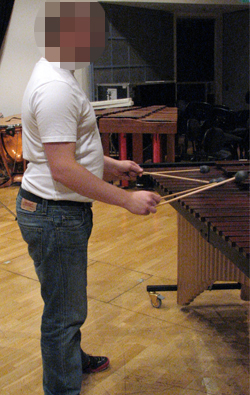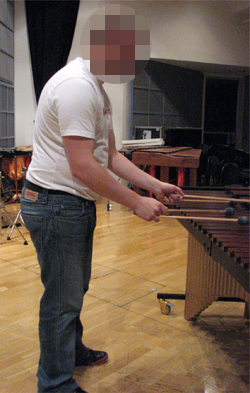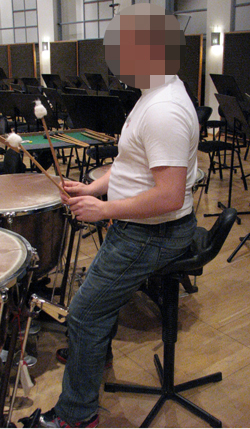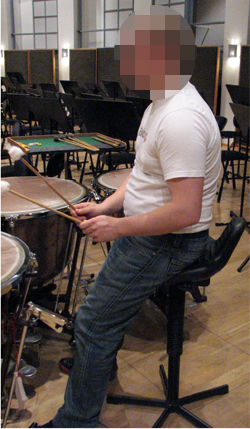Percussion - harjoittelu
Percussion
Read the Ergonomics Overview first.
A good percussion technique is based on good control of the body and good muscular support for relaxed arm movement. Good body control starts by finding the right position of the pelvis and the spine.
The body's centre position is the basic position to which the musician always returns. In the centre position, the spine maintains its natural curves. Spinal curves vary between individuals; in the centre position, the backs and hips of different people may look different.
In order to find the correct posture, the musicians should first examine the position of their pelvis. The pelvic centre position can be found, for example, by first pushing the pelvis as far in and out as possible. The centre position provides optimal mobility of the pelvis and good control of the deep abdominal muscles. Furthermore, the pelvic centre position helps the musician to maintain the centre position in the thoracic spine and the rib cage. The centre position of the thoracic spine can be found through extreme positions. When the thoracic spine and the rib cage are in the centre position, breathing is easy, the breastbone is in a vertical position and the back extensors are engaged but not tense.
The rib cage/thoracic spine and the pelvis should be aligned when viewed from the side. The centre position of the head and neck can be found by first moving the head forwards and backwards, then leaving it in the centre position where there is free movement between the skull and the cervical spine.
A correct position of the thoracic spine and the rib cage enables optimal muscular support for the shoulder blades. In turn, these muscles ensure relaxed and strong arm movement. The shoulder blades should be in a vertical position against the ribs, encouraging a natural position of the shoulders. If the shoulder blade tilts forward and/or wings off, the shoulder blades have insufficient muscular support, causing strain in the neck and shoulder area and the upper limbs.
A typical faulty position for percussionists involves dropping the shoulder blades and tilting them forward, pushing the shoulders forward and down. For example, when playing the marimba, the mallet should hit the keys in a horizontal position. If the instrument is too low, the musician is forced to bend forward and drop the shoulders in order to find the right percussion angle. Therefore, the right height of the instrument is particularly important.
|
The pelvis and the spine are in the centre position; the shoulder blades are in a vertical position and supported against the ribs. |
The instrument is too low, causing the back to curve and shoulder blades to drop and tilt forward. |
Percussionists are most prone to tilting their pelvis back, which straightens the lumbar spine and curves the thoracic spine. The centre position of the pelvis and the spine is the basic position which allows the musician to move freely during playing. For example, when playing the timpani, the percussionist uses his or her body movement to add force to a blow.
|
The pelvis and the spine are in the centre position; the shoulder blades are in a vertical position and supported against the rib cage. |
The pelvis tilts back, the spine is curved, causing the shoulder blades to drop and tilt forward. |
The basic grip of the mallet should be such that the wrist is extended 15 degrees (up) and tilted 15 degrees towards the little finger. This facilitates free finger movement and optimal action of the deep muscles that support the hand. Forearm problems are common among percussionists. One cause of strain injuries is the faulty position of the wrist and/or hand.




